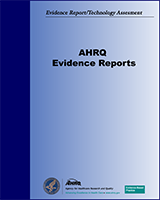NCBI Bookshelf. A service of the National Library of Medicine, National Institutes of Health.
This publication is provided for historical reference only and the information may be out of date.
Structured Abstract
Objectives:
To conduct a systematic review of the use and quality (including underuse, overuse, and misuse) of appropriate colorectal cancer (CRC) screening, including factors associated with screening, effective interventions to improve screening rates, current capacity, and monitoring and tracking the use and quality. Trends in the use and quality of CRC screening tests is also presented.
Data sources:
We searched MEDLINE®, the Cochrane Library, and the Cochrane Central Trials Registry, supplemented by handsearches, for studies published in English from January 1998 through September 2009.
Review methods:
We used standard Evidence-based Practice Center methods of dual review of abstracts, full text articles, abstractions, quality rating, and quality grading. We resolved disagreements by consensus.
Results:
We found multiple problems of underuse, overuse, and misuse of CRC screening. We identified a total of 116 articles for inclusion into the systematic review, including a total of 72 studies qualified for inclusion for key question (KQ) 2, 21 for KQ 3, 12 for KQ 4, and 8 for KQ 5. A number of patient-level factors are associated with lower screening rates, including having low income or less education, being uninsured or of Hispanic or Asian descent, not being acculturated into the United States, and having less or reduced access to care. Being insured, of higher income or education, and non-Hispanic white, participating in other cancer screenings, having a family history of CRC or personal history of another cancer, as well as receiving a physician recommendation to be screened, are associated with higher screening rates. Interventions that effectively increased CRC screening with high strength of evidence include patient reminders, one-on-one interactions, eliminating structural barriers, and system-level changes. The largest magnitude of improvement came from one-on-one interactions and eliminating barriers. Purely educational small-media interventions do not improve screening rates. Evidence is mixed for decision aids, although certain designs may be effective. No studies tested interventions to reduce overuse or misuse of CRC screening. We found no studies that assessed monitoring systems for underuse, overuse, and misuse of CRC screening. Modeling studies, using various assumptions, show that if the United States were to adopt a colonoscopy‐only approach to CRC screening and everyone were to agree to be screened in this way, it is likely that colonoscopy capacity would need to be substantially increased.
Conclusions:
Both CRC screening and patient-physician discussions of CRC screening are underused, and important problems of overuse and misuse also exist. Some interventions hold promise for improvement. The research priority is to design and test interventions to increase screening and CRC screening discussions, building on the effective approaches identified in this review, and tailored to specific population needs. In addition, new interventions to reduce overuse and misuse should be designed and tested, along with studies of ongoing monitoring systems that are linked to feedback and continued improvement efforts.
Contents
- Preface
- Executive Summary
- 1. Introduction
- 2. Methods
- 3. Overview of Trends in Use and Quality of CRC Screening
- 4. Results
- KQ 2: What Factors Influence the Use of Colorectal Cancer Screening?
- Summary
- KQ 3: Which Strategies Are Effective In Increasing The Appropriate Use Of Colorectal Cancer Screening And Followup?
- KQ 4: Current and Projected Capacity to Deliver Colorectal Cancer Screening and Followup
- KQ 5: Effective Approaches for Monitoring Use and Quality of Colorectal Cancer Screening
- 5. Discussion
- References
- List of Abbreviations
- Glossary
- Appendixes
Prepared for: Agency for Healthcare Research and Quality, U.S. Department of Health and Human Services.1 Contract No. 290-2007-10056-I. Prepared by: RTI International–University of North Carolina Evidence-based Practice Center.
Suggested citation:
Holden, DJ, Harris, R, Porterfield, DS, Jonas, DE, Morgan, LC, Reuland, D, Gilchrist, M, Viswanathan, M, Lohr, KN, Lyda-McDonald, B. Enhancing the Use and Quality of Colorectal Cancer Screening. Evidence Report/Technology Assessment No.190. (Prepared by the RTI International–University of North Carolina Evidence-based Practice Center under Contract No. 290-2007-10056-I.) AHRQ Publication No. 10-E-002. Rockville, MD: Agency for Healthcare Research and Quality. February 2010.
This report is based on research conducted by the RTI International – University of North Carolina at Chapel Hill, North Carolina (RTI-UNC) Evidence-based Practice Center (EPC) under contract to the Agency for Healthcare Research and Quality (AHRQ), Rockville, MD (Contract No. 290‐2007-10056-I). The findings and conclusions in this document are those of the author(s) who are responsible for its contents; the findings and conclusions do not necessarily represent the views of AHRQ. Therefore, no statement in this article should be construed as an official position of the Agency for Healthcare Research and Quality or of the U.S. Department of Health and Human Services.
The information in this report is intended to help health care decision-makers; patients and clinicians, health system leaders, and policymakers, make well-informed decisions and thereby improve the quality of health care services. This report is not intended to be a substitute for the application of clinical judgment. Decisions concerning the provision of clinical care should consider this report in the same way as any medical reference and in conjunction with all other pertinent information, i.e., in the context of available resources and circumstances presented by individual patients.
This report may be used, in whole or in part, as the basis for development of clinical practice guidelines and other quality enhancement tools, or as a basis for reimbursement and coverage policies. AHRQ or U.S. Department of Health and Human Services endorsement of such derivative products may not be stated or implied.
No investigators have any affiliations or financial involvement (e.g., employment, consultancies, honoraria, stock options, expert testimony, grants or patents received or pending, or royalties) that conflict with material presented in this report.
- 1
540 Gaither Road, Rockville, MD 20850. www
.ahrq.gov
